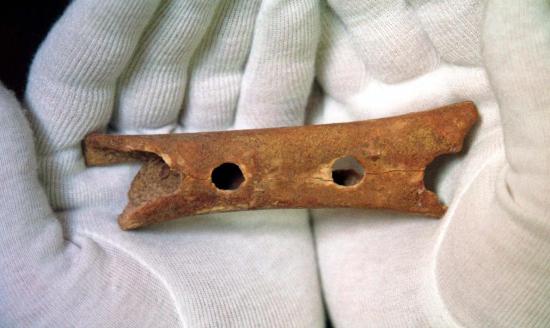Ralph Martins
Source - http://news.nationalgeographic.com/2015/03/150331-neanderthals-music-oldest-instrument-bones-flutes-archaeology-science/

A bear bone found at the Divje Babe site in Slovenia was thought to be an ancient musical instrument made by Neanderthals, but new research suggests its holes were made by the teeth of animals. PHOTOGRAPH BY REUTERS
Once thought to be the earliest musical instruments, bone artifacts called “Neanderthal flutes” were actually the work of scavenging hyenas, a new study says.
Discovered in caves in southeast Europe, the “flutes” are thigh bones from juvenile cave bears with regular circular punctures that look like finger holes. The most famous of these, the 43,000-year-old Divje Babe flute, was found in a Slovenian cave in 1995.
Scientists have debated whether these “flutes” were made by Neanderthals or by scavengers gnawing on bones. To answer this, paleobiologist Cajus Diedrich examined bone breakage patterns and prehistoric animal remains in 15 cave locations, looking for evidence that the punctures were made by animals.
The study, published Tuesday in Royal Society Open Science, found that “Neanderthal bone flutes” did not bear the marks of stone drills, but of Ice Age hyenas’ teeth, which were able to puncture the soft bones of young bears.
Why It Matters
“Most paleoanthropologists accept that the Divje Babe ‘flute’ is a carnivore-chewed bone, but you do see it referred to as a flute from time to time,” says April Nowell, an archaeologist at the University of Victoria in Canada.
The Divje Babe artifact dates back to Neanderthal times, and the National Museum of Slovenia describes it as a “Neanderthal flute.” There are several others like it, but the study observes that many of these do not actually date back to Neanderthal times.
The discovery of their origins means that there is now no evidence that Neanderthals made musical instruments.
The Big Picture
If the Neanderthals weren’t the first to make musical instruments, who was?
That accomplishment stands with people from the Aurignacian culture of southwest Germany, who made flutes with vulture bones and mammoth ivory 40,000 years ago. (Read “The First Artists” in National Geographic magazine.)
These flutes look more like modern instruments, and bear clear evidence of toolwork. (Read about the Aurignacian flutes.)
Nicholas Conard, an archaeologist at the University of Tübingen in Germany, writes that making music would have allowed these modern humans to strengthen social bonds, which could have helped them to organize their societies and expand more effectively than the Neanderthals.
What’s Next
The Neanderthals may have made music without instruments by clapping their hands or slapping their bodies, Nowell notes. They may also have used instruments made of materials that decomposed.
But no evidence of instruments or musical behavior has yet been found, and the truth about the Divje Babe “flute” will help to “dismantle a myth that has been too persistent in some circles,” Nowell says.